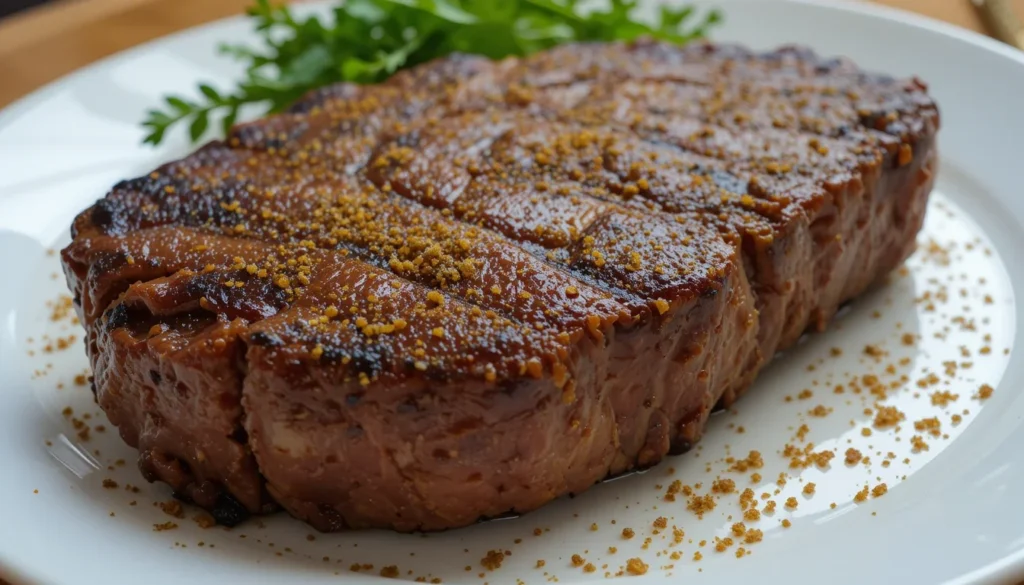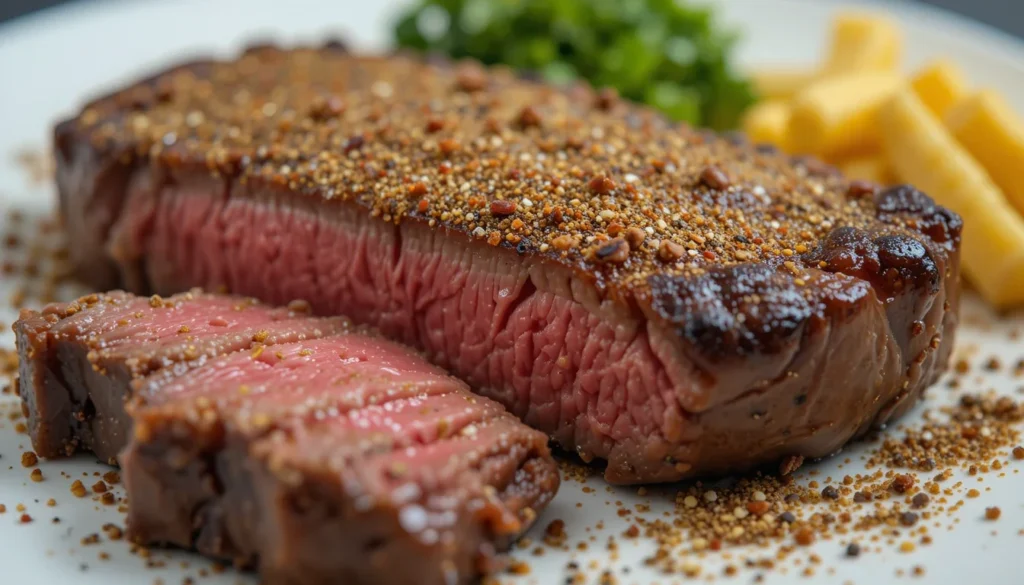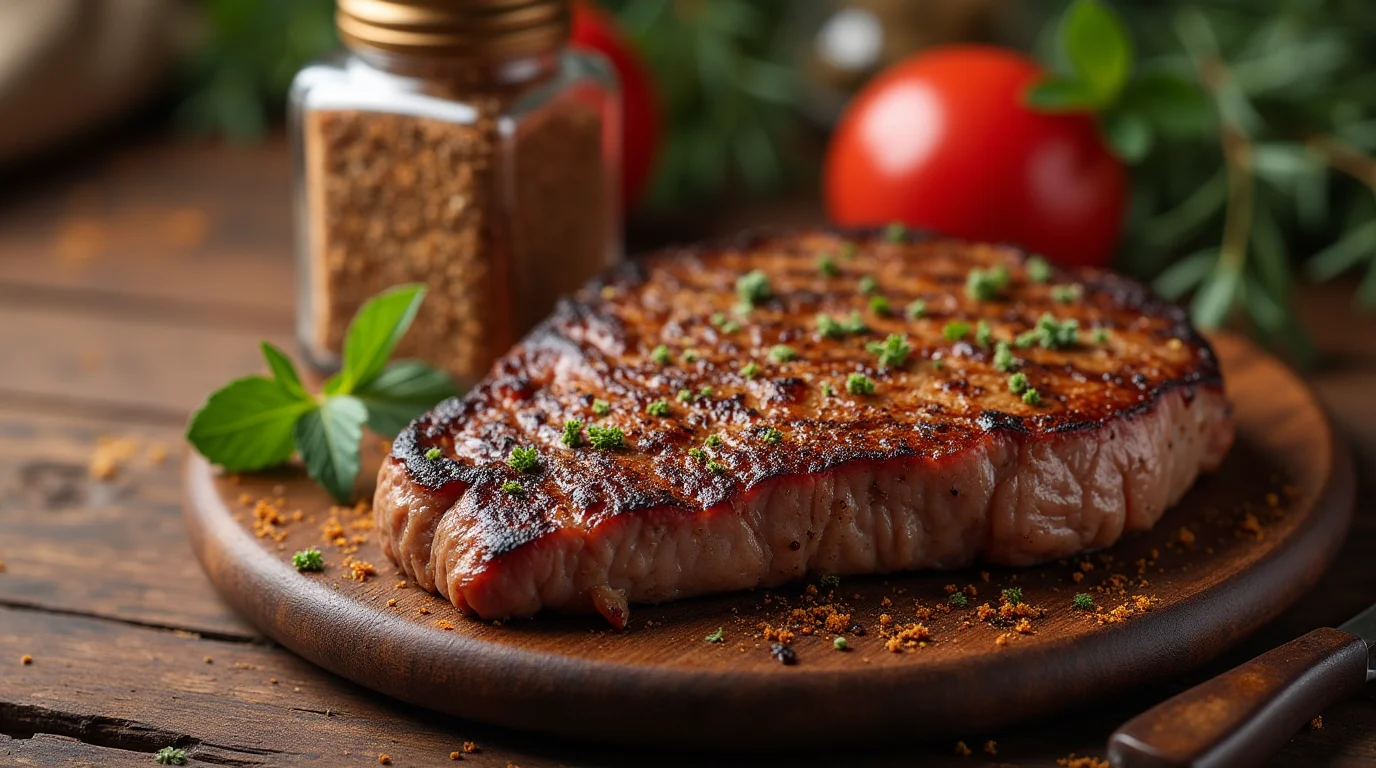Table of Contents
Introduction: Why Steak Seasoning Matters
A perfectly seasoned steak can make the difference between a good meal and an unforgettable one. While high-quality beef is essential, how you season it determines how flavorful and juicy it turns out. Steak seasoning enhances the natural taste of the meat, brings out its umami richness, and helps develop that delicious crust when cooked properly.
There is a common misconception that steak only needs salt and pepper—while this is a classic approach, many seasonings can complement the flavors of different cuts. Using a blend of garlic, onion, smoked paprika, and herbs adds depth and character to your steak.
Understanding the science behind seasoning can improve your cooking significantly. Factors such as:
- How salt draws out moisture and creates a flavorful crust.
- The role of herbs and spices in balancing the steak’s richness.
- The best techniques for applying seasoning to maximize flavor.
This guide will take you through the fundamentals of steak seasoning, different types of blends, proper application techniques, common mistakes, and even creative ways to use your seasoning beyond steak. Let’s dive into the world of seasonings and elevate your next steak to perfection!
The Science Behind Steak Seasoning
To truly master steak seasoning, it’s important to understand how the different ingredients interact with meat. The key elements that define a good seasoning blend are:
1. The Role of Salt in Steak Seasoning
Salt is the foundation of any good steak seasoning. It enhances flavor by breaking down muscle proteins, allowing the meat to retain moisture. The process of osmosis pulls the natural juices to the surface, creating a flavorful crust when cooked.
Using the right kind of salt matters:
- Kosher salt – Best for even seasoning due to its coarse texture.
- Sea salt – Adds a natural, slightly mineral taste.
- Table salt – Too fine, making it easy to over-season.
For more on how salt interacts with meat, check out this guide on USDA safe cooking guidelines.
2. Why Garlic, Onion, and Herbs Enhance Flavor
Beyond salt, other ingredients add complexity:
- Garlic powder and onion powder intensify umami notes.
- Smoked paprika gives a mild smokiness, mimicking open-fire grilling.
- Rosemary and thyme add freshness, cutting through the steak’s richness.
According to Healthline, these ingredients not only enhance flavor but also provide antioxidants and health benefits.
Essential Ingredients in a Classic Steak Seasoning Blend

A well-balanced steak seasoning blend should include a mix of salt, spice, and aromatics.
Classic Homemade Steak Seasoning Recipe
This blend works on any cut of beef:
- 2 tbsp kosher salt
- 2 tbsp black pepper
- 2 tbsp garlic powder
- 1 tbsp smoked paprika
- 1 tbsp onion powder
- 2 tsp dried rosemary
- 2 tsp dried thyme
Customizing Your Blend
Want to tweak your seasoning for different flavors? Try these variations:
✔ Spicy Steak Rub – Add ½ tsp cayenne pepper or red pepper flakes.
✔ Sweet & Smoky Rub – Mix in 1 tbsp brown sugar for caramelization.
✔ Coffee-Rubbed Steak – Use 1 tbsp finely ground coffee for depth.
Each ingredient plays a role in complementing the steak’s natural flavors. The key is balance—no one spice should overpower the others.
How to Properly Apply Steak Seasoning
1. When to Season Steak
Timing is everything:
- 40+ minutes before cooking: Allows the salt to penetrate deeply.
- Right before cooking: Ensures the salt stays on the surface, forming a crispy crust.
2. How Much Seasoning to Use
A good rule of thumb:
✔ 1 tsp per pound of meat for balanced flavor.
✔ Increase slightly for thicker cuts like ribeye or T-bone.
3. Techniques for Even Seasoning
- Pat the steak dry before seasoning.
- Sprinkle seasoning evenly over both sides.
- Press (don’t rub) the seasoning to help it stick.
Applying seasoning properly ensures an even flavor distribution throughout the steak.
Different Types of Steak Seasoning Blends
Not all steaks require the same seasoning. The right blend enhances the natural flavor of the meat and complements different cooking styles. Below are several regional and specialty steak seasoning blends, each bringing a unique twist to your steak.
1. Montreal Steak Seasoning (Bold & Peppery)
Origin: This blend comes from Canadian steakhouses, known for their flavorful crust and coarse seasoning. It’s a pepper-heavy mix that delivers a punchy, savory bite.
✔ Ingredients:
- 2 tbsp kosher salt
- 1 tbsp black pepper (coarsely ground)
- 1 tbsp garlic powder
- 1 tbsp onion flakes
- 1 tbsp crushed coriander seeds
- 1 tsp dill seeds
- ½ tsp red pepper flakes
Best For:
- Grilled steaks (ribeye, strip steak, porterhouse).
- Burgers for an extra smoky flavor.
- Roasted or grilled vegetables.
Cooking Tip: Apply liberally and let the steak rest for at least 30 minutes to absorb the flavors.
2. Texas-Style Dry Rub (Smoky & Spicy)
Origin: Inspired by Southern BBQ flavors, this rub adds a rich, smoky, and slightly sweet taste to your steak.
✔ Ingredients:
- 2 tbsp kosher salt
- 2 tbsp black pepper
- 1 tbsp chili powder
- 1 tbsp smoked paprika
- 1 tbsp brown sugar
- 1 tsp cumin
- ½ tsp cayenne pepper
Best For:
- Thick-cut steaks like tomahawk and porterhouse.
- Smoked brisket.
- Grilled short ribs.
Cooking Tip: This rub is great for low-and-slow cooking or grilling over wood chips for extra smokiness.
3. Espresso Steak Rub (Rich & Earthy)
Origin: Coffee-based rubs have gained popularity in gourmet kitchens due to their ability to enhance the steak’s natural umami flavor. The coffee creates a deep crust that pairs well with smoky grilling.
✔ Ingredients:
- 2 tbsp kosher salt
- 2 tbsp black pepper
- 1 tbsp finely ground espresso coffee
- 1 tbsp garlic powder
- 1 tbsp onion powder
- 1 tsp cocoa powder (optional, adds more depth)
Best For:
- Bone-in ribeye or tomahawk steaks.
- Reverse-seared or smoked steaks.
- Grilled burgers.
Cooking Tip: Let the rub sit on the steak for at least an hour before grilling to allow the coffee to penetrate and tenderize the meat.
4. Cajun Steak Seasoning (Spicy & Zesty)
Origin: Cajun seasoning originates from Louisiana and is known for its bold, spicy, and slightly smoky profile.
✔ Ingredients:
- 2 tbsp kosher salt
- 2 tbsp black pepper
- 1 tbsp cayenne pepper
- 1 tbsp paprika
- 1 tbsp garlic powder
- 1 tbsp onion powder
- 1 tsp dried oregano
- 1 tsp dried thyme
Best For:
- Grilled steaks with blackened seasoning.
- Cajun-style steak fajitas.
- Shrimp or seafood dishes.
Cooking Tip: Cook over high heat to develop a spicy, crispy crust while keeping the inside juicy.
5. Herb Butter Steak Seasoning (Fresh & Aromatic)
Origin: A European-inspired seasoning, this blend combines dry seasonings with fresh herbs and butter for an extra luxurious steak finish.
✔ Ingredients:
- 2 tbsp kosher salt
- 1 tbsp black pepper
- 1 tbsp garlic powder
- 1 tbsp onion powder
- 1 tbsp fresh rosemary (finely chopped)
- 1 tbsp fresh thyme (finely chopped)
- ½ cup unsalted butter (softened)
Best For:
- Filet mignon and sirloin steaks.
- Pan-seared and butter-basted steaks.
- Finishing sauce for roasted vegetables.
Cooking Tip: Cook your steak as usual, then melt a spoonful of the herb butter over it while it rests.
6. Chimichurri Dry Rub (Tangy & Herbaceous)
Origin: Inspired by the famous Argentinian chimichurri sauce, this dry rub delivers a tangy, garlicky kick with a fresh herbal finish.
✔ Ingredients:
- 2 tbsp kosher salt
- 1 tbsp black pepper
- 1 tbsp garlic powder
- 1 tbsp onion powder
- 1 tbsp dried parsley
- 1 tbsp dried oregano
- 1 tsp crushed red pepper flakes
- ½ tsp lemon zest
Best For:
- Grilled sirloin or flank steak.
- Argentinian-style grilled meats.
- Topping for tacos or grilled vegetables.
Cooking Tip: After cooking, drizzle with olive oil and a squeeze of fresh lime juice for extra zest.
7. Garlic Parmesan Steak Seasoning (Savory & Cheesy)
Origin: This seasoning takes inspiration from Italian cuisine, adding a cheesy, umami-rich layer to your steak.
✔ Ingredients:
- 2 tbsp kosher salt
- 2 tbsp black pepper
- 1 tbsp garlic powder
- 1 tbsp grated Parmesan cheese
- 1 tbsp Italian seasoning
- ½ tsp red pepper flakes
Best For:
- Pan-seared steaks.
- Steakhouse-style filet mignon.
- Garlic butter roasted potatoes.
Cooking Tip: Sprinkle Parmesan over the steak right after cooking for a melty, crispy topping.
Best Cooking Methods for Seasoned Steaks
Once your steak is seasoned, the cooking method determines how well the flavors develop.
✔ Reverse Sear – Ideal for thick steaks, creating a perfect crust.
✔ Pan-Searing – Maximizes caramelization with butter basting.
✔ Grilling – Infuses smoky char for outdoor cooking.
✔ Sous Vide – Locks in seasoning before searing.
Common Steak Seasoning Mistakes to Avoid
Using too much salt – Can dry out your steak.
Seasoning too early – Can result in a dry exterior.
Overpowering with spices – A balanced blend is key.
Avoid these pitfalls for the best flavor!
Creative Uses for Steak Seasoning Beyond Steak
A good seasoning blend works on more than just steak! Try it on:
✔ Grilled vegetables like zucchini and mushrooms.
✔ Chicken and pork for extra flavor.
✔ Potatoes or fries for a savory twist.
✔ Burgers for enhanced taste.
FAQs About Steak Seasoning

1. What should I season my steak with?
Start with the basics:
- Salt: Use kosher salt or sea salt to draw out moisture and enhance flavor.
- Black Pepper: Freshly ground for a sharp, pungent kick.
- Garlic & Onion Powder: Adds depth and umami.
- Smoked Paprika: Gives a subtle smokiness.
- Herbs: Rosemary and thyme for a fresh, aromatic touch.
For extra flavor, try a rub with cayenne pepper, brown sugar, or ground coffee.
2. What is the 3-3-3 rule for steaks?
This grilling technique helps you achieve a perfect crust:
- Sear on high heat for 3 minutes on one side.
- Flip and sear for another 3 minutes.
- Turn the heat down or move to indirect heat for the final 3 minutes.
This method works best for steaks about 1-inch thick.
3. How to make steak taste better?
- Dry brine with salt: Season generously and let it rest in the fridge for 1-24 hours.
- Use a flavorful rub: Try blends with smoked paprika, cumin, or coriander.
- Baste with butter, garlic, and herbs: This adds richness and moisture.
- Let the steak rest: Gives juices time to redistribute for maximum flavor.
4. What spices does Gordon Ramsay use on steak?
Gordon Ramsay keeps it simple yet flavorful:
- Sea salt and freshly ground black pepper for seasoning.
- Garlic cloves and fresh thyme in the pan while cooking.
- Finishes with a generous butter baste to enrich the flavor.
5. What herbs to put on steak?
- Classic Herbs: Rosemary, thyme, oregano, and parsley.
- Bold Choices: Sage, tarragon, or a sprinkle of chopped chives.
- Herb Butter: Combine butter, garlic, and fresh herbs to melt over the steak after cooking.
6. How to season meat properly?
- Pat the meat dry: This helps the seasoning stick better.
- Apply salt first: Use kosher salt to draw out moisture and flavor the inside.
- Layer with other spices: Black pepper, garlic powder, and any herbs you like.
- Let it rest: Allow seasoning to penetrate for at least 30 minutes (or overnight in the fridge).
7. What adds flavor to steak?
- Fat: Marbling in the meat plus a butter baste.
- Spices and herbs: Smoked paprika, garlic, rosemary, and thyme.
- Searing: High heat creates a flavorful crust through the Maillard reaction.
- Resting: Keeps the steak juicy and enhances overall flavor.
8. How to make your own seasoning
Here’s a simple yet amazing blend:
- 2 tbsp kosher salt
- 2 tbsp black pepper
- 1 tbsp smoked paprika
- 1 tbsp garlic powder
- 1 tbsp onion powder
- 2 tsp dried rosemary
- 2 tsp dried thyme
Combine and store in an airtight jar!
9. When to add butter to steak?
Right after cooking: Let a knob of butter melt over the hot steak while it rests to create a rich, silky finish.
During the last few minutes of cooking: Baste the steak with melted butter, garlic, and herbs.
Final Thoughts: Mastering Steak Seasoning
By understanding the right blends, application methods, and cooking techniques, you can create a perfectly seasoned steak every time. Whether you prefer a simple salt-and-pepper approach or a bold spice rub, the key is balance and precision.
A well-seasoned steak doesn’t just depend on the ingredients—it’s also about technique. From choosing the right salt to experimenting with flavorful herbs and spices, every step adds to the final taste. Plus, learning how to apply seasoning correctly ensures that every bite is packed with flavor.
If you’re a fan of perfectly seasoned meats, you may also enjoy trying this Smoked Chicken Drumsticks Recipe, which showcases another way to use dry rubs for maximum flavor. And for those who love grilling, check out this Best Bacon Cheeseburger Recipe for a delicious burger packed with smoky goodness.


10 thoughts on “The Ultimate Guide to Steak Seasoning”